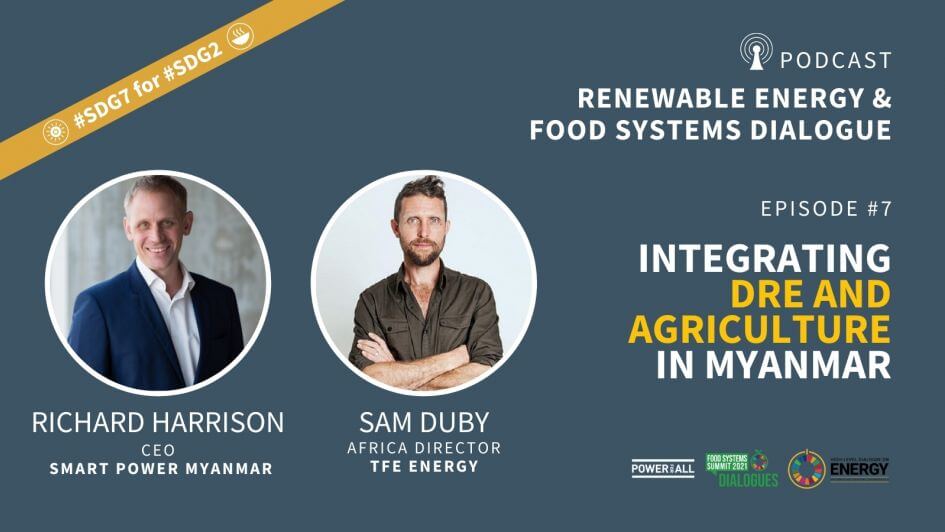In this episode of the Power for All podcast, William Brent speaks with Richard Harrison, the head of Smart Power Myanmar. Richard is joined by Sam Duby, research partner of Smart Power Myanmar, who is from TFE Energy. In support of this year's UN food system summit, this conversation is part of a special series on the critical link between food systems and decentralized renewable energy. This discussion aims to shed light on game-changing ideas in Africa and Asia that can help ensure sustainable energy for all, improve farmers' lives and support economic growth.
Filling the Information Gaps
Myanmar has one of the lowest electrification rates compared to other countries in South-East Asia. Approximately 30% of its GDP, and 70% of the country’s livelihood comprises income from the agricultural value chain. To address this gap, Smart Power Myanmar has released a report with data and ground breaking research through an ecosystem view of energy access in Africa, to understand the various ways in which this issue can be dealt with.
The mini-grid developers were investing in value chains based off of guess-work, and communities lacked finance in the DRE space. Financial institutions, donors, and multilaterals had very little understanding of how DRE would be translated efficiently and effectively into productive use financing. The research was conducted mainly to streamline these processes and fill in information gaps. For upscaling DRE in a country or creating replicable models, investments must be made in value chains that are complex systems, interconnected like trees. It is required to reverse engineer them all the way down to selection of sites for mini grids. Thus, the research commissioned through TFE in Myanmar has revealed what is required to build the DRE ecosystem and the local economy.
One of Smart Power’s projects in the south of Myanmar, involved a small village that was in the cockle farming occupation. The villagers were using diesel to power their generator that was used to pump water, and power the water jets that were involved in cleaning and processing the fish. With financial assistance from the World Bank and another partner, Smart Power was able to connect these farmers to a solar mini grid. This enabled them to switch to electric motors. This provides energy to the water pumps, the water jets used for cleaning, along with generating water for the entire village of 4000 people. Now, 60% of the village receives piped water. This project highlights the very definition of productive-use which is not limited to the business activity alone, but essential services like water.
Insights
The Myanmar Power Map is a site selection tool developed to integrate various variables such as solar radiation data, services and utilities available in a region and which allows for strategic planning of which crops to grow and the integration of DRE in this value chain. It is also valuable for investors and private suppliers to understand the viability of the system and the benefits it could accord to the communities.
The Power Map essentially drives the supply dimension of DRE. Looking at the demand dimension, each crop has different energy demand across and down its value chain. The research by TFE focussed on developing methodology to compare the usage of energy of different crops, at different places on the value chain. This was narrowed down to value added per kilowatt hour of energy used. For example, unthreshed rice when threshed with an energy cost has a higher value. But this metric alone is not enough to compare crops. A certain qualitative understanding is also required to make an accurate assessment since some crops have a larger fixed investment such as machinery. Thus, this assessment is used to arrive at a crop that is best suited for the use of DRE.
Moreover, the on-grid and off-grid choice are ends of a spectrum rather than binary options. For example, rice fishing is more suitable for off-grid simply because of its scale towards more upstream village level off-grid interventions, like mini grids, whereas more downstream, bigger processes like color-bean sorting or cotton yarn-making tends to happen downstream because of the economies of scale required to buy the machinery. Now since on-grid supply is not reliable due to poor quality, a yarm-making factory might benefit from their lower tariffs on grid connection, but incur larger operation cost when the machines are idle. If there’s a solar panel on the factory’s roof, or even purchased from a private supplier, it might be more viable for the community, even if solar is priced slightly higher.
Within the current scenario in Myanmar, opportunities are viable at the village and town levels, as aggregate solar for industries and other such collective purposes. Financial institutions have also recently shown interest in the CNI space.
Suggested State Action
The current infrastructure in Myanmar is poor. Smart Power has been actively engaging with agricultural finance organisations to integrate electrification as a key part of agri development and adding to the value chain. The goal is to bring resilience into communities in rural electrification through DRE integration in agricultural planning. The mini grid consumption doubled during the Covid-19 pandemic and there is reason to believe that people’s attitude towards investment in electricity has shifted.
Agriculture can support energy but energy can also support agriculture. Picking up on that from a perspective of advice to governments is to provide an enabling environment within an enabling ecosystem. The private sector can do much of the heavy lifting with regards to rural electrification, and with laying the foundations for rural industrialization. Additionally, governments should tailor their interventions to different parts of the value chain, wherein financial and technical assistance would be required in the rural home spaces, a different intervention would be required in a small industry or rural industrial space. Finally, it is important to view agricultural and energy resources as interconnected rather than as separate sectors to be developed.
